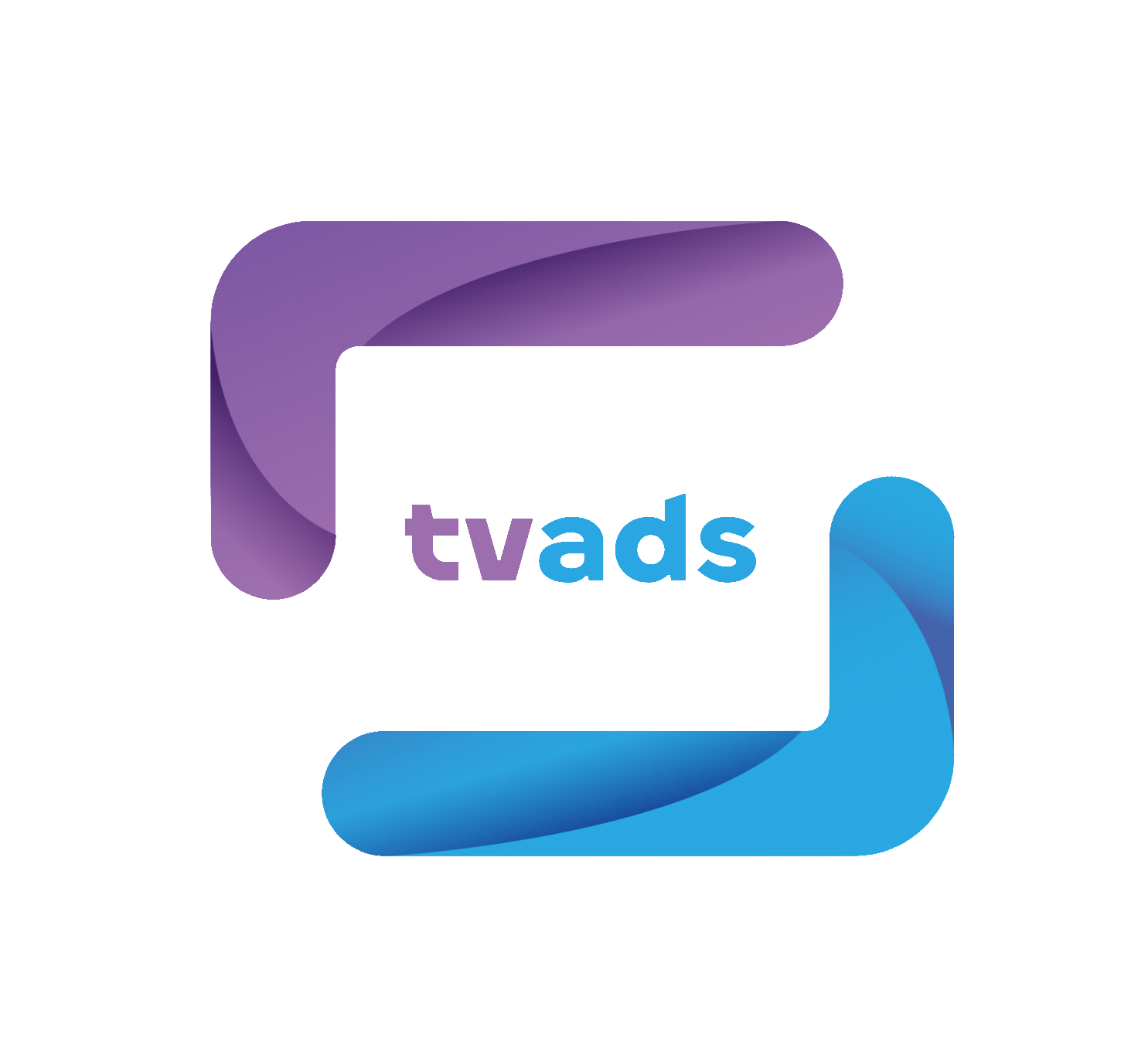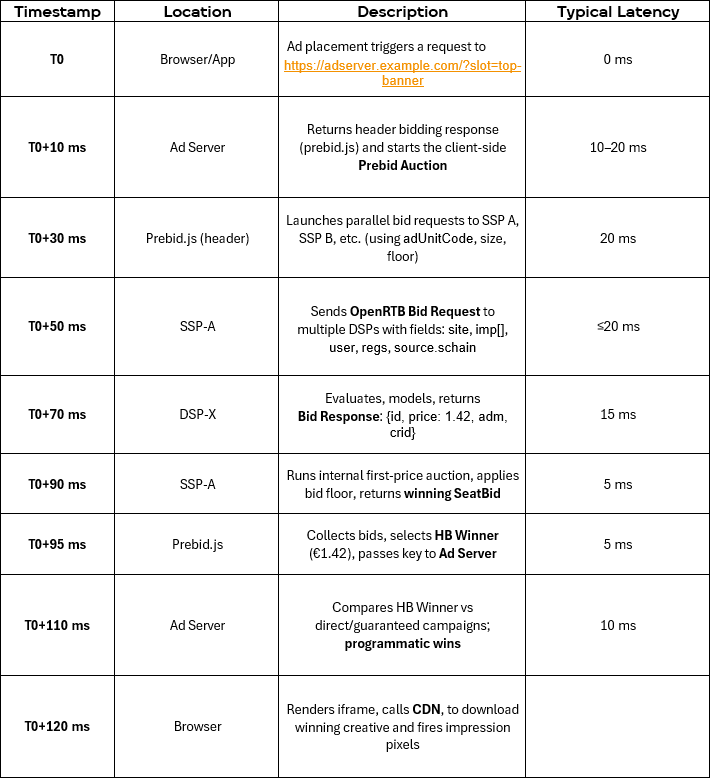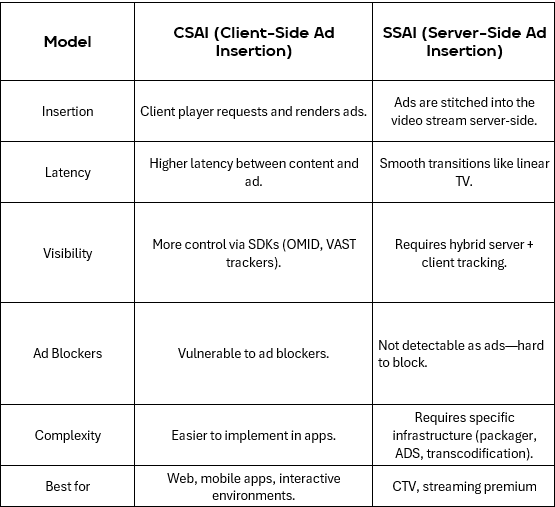

In a previous article article , we explored the adoption of a new way of selling digital advertising programmatically—we looked at its history, growth, expansion, and the future challenges it faces. In this post, we will dive deeper into the technical and technological aspects of the automated buying and selling process, in which technology plays a fundamental role—without it, the programmatic ecosystem that emerged two decades ago wouldn't exist as we know it today.
Let's start with a brief summary and description of the main tools involved in this process, followed by a detailed breakdown of the programmatic flow.
Now that we have introduced the main actors in the programmatic selling ecosystem, let's walk through a complete RTB flow step-by-step. It's important to note that all these platforms and tools communicate through IAB Tech Lab standards like OpenRTB (read more about OpenRTB in this article), VAST, OMID, ads.txt, Sellers.json, etc., ensuring consistency, transparency, and protection against fraud.
Before diving into the programmatic buying process, we must understand the concept of the CMP (Consent Management Platform)—responsible for collecting, storing, and managing user consent in compliance with GDPR. Consent is transmitted in the form of an alphanumeric string in subsequent programmatic calls (or non-consent) between SSPs and DSPs.
1. Ad Request – A user loads a page/app, triggering the ad tag or SDK to send a request to the Ad Server or directly to the SSP.
2. Bid RequestThe SSP packages the impression with device, user, and site/app data, including consent (if available), in an OpenRTB 2.6 message and sends it to the DSPs.
3. Decisioning in the DSP
User Sync / Identity: The DSP recognizes the user and values them.
DMP Query: To qualify the user.
Machine Learning Models: Predict win rate.
Bid Calculation: The bid (CPM) is calculated, and the Bid Response is generated.
4. AuctionThe Ad Exchange executes a first-price (or second-price) auction. Floor prices, Deal IDs, and SPO rules may apply.
5. Win Notice & Ad Markup The winner is notified, and the user downloads the creative via CDN. Impression, viewability (OMID), and interaction pixels are fired.
6. Reporting– DSP, Exchange, and SSP logs are processed, and incrementality or multi-touch attribution models are applied.
Example Flow with Estimated Timings

There is an important part in this whole process that we have not discussed, and that appears on several occasions, is the header bidding, is a tool that allows the Ad Server to receive simultaneous bids from multiple SSPs, avoiding the traditional cascade (waterfall) that adds latency times. There are two types of header bidding, the one that occurs on the client (Client Side) is usually a small JS library, which has lower bidding latency, but higher page load latency since it is where the header bidding occurs. On the contrary, if this HB is produced on the Server Side with technologies such as S2s / Prebid, the latency on the page is reduced and the page load time is optimized.
Having seen the generic process, it is important to note that this sales model can be predefined beforehand if a commercial agreement has been established between the Publisher and the buyer, depending on this type of negotiation, we can differentiate between several types of purchase:
Each model provides different levels of access and control over inventory.
It is important to mention some of the standards that are followed for the whole process to occur safely, we have already mentioned that its language will be Open RTB, but it is always important to highlight additional tools such as ads.txt / app-ads.txt files where the entire list of authorized sellers on the inventory of a Publisher are reflected. The Sellers.json where the relationship between the intermediary and the Publisher in question, is declared or the complete supply chain where parameters are added as a bid request chain is executed.
You can read more about these standards in our previous article on the RTB ecosystem.
Connected TV (CTV) and OTT (Over-the-Top) represent the convergence of traditional audiovisual content and the automated digital ecosystem. Programmatic advertising has transformed monetization in these environments, offering efficiency, precision, and scalability. The two main models for ad insertion in CTV are SSAI (Server-Side Ad Insertion) and CSAI (Client-Side Ad Insertion) which we detail in this article, and their choice depends on technical, operational and measurement factors.
It may be easier to retrieve a brief summary of the main characteristics of each of them:

Both models use VAST (Video Ad Serving Template) for describing creatives, events, and tracking. SSAI is increasingly dominant in CTV for delivering a seamless, buffer-free experience.
Emerging hybrid models like SGAI (Server-Guided Ad Insertion) combine the best of CSAI and SSAI, enabling both premium experience and interactivity.
Programmatic advertising is only just beginning its evolution. With today’s exponential tech growth, it’s inevitable that programmatic will evolve alongside it. Generative AI for dynamic creative generation—like prompt to banner or prompt to video—is poised to redefine creative production.
Programmatic buying is no longer optional, it is essential. For media owners, it represents a powerful opportunity to monetize premium inventory efficiently, maximizing fill rate and yield per impression. SSAI models and the adoption of private deals (PMPs, Programmatic Guaranteed) enable broadcasters and OTT platforms to retain control over ad quality and brand experience.
For advertisers, programmatic in CTV means reaching segmented audiences at scale, with data-driven optimization and measurement. It enables 1P data activation, frequency control, real-time pacing, and access to high-impact screens like Smart TVs. This democratizes access to TV inventory, previously reserved for large budgets, and enhances result measurement (incrementality, attention, brand lift).
For users, programmatic improves the ad experience—making it more relevant, less repetitive, and smoothly integrated into content. Well-executed SSAI models remove black screens and disruptions, while smart frequency and segmentation strategies reduce ad fatigue.
At tvads we has a professional team able to advise you on this field and and guide you in any area of your streaming advertising business, advising you or even operating it on your behalf if necessary
All author posts